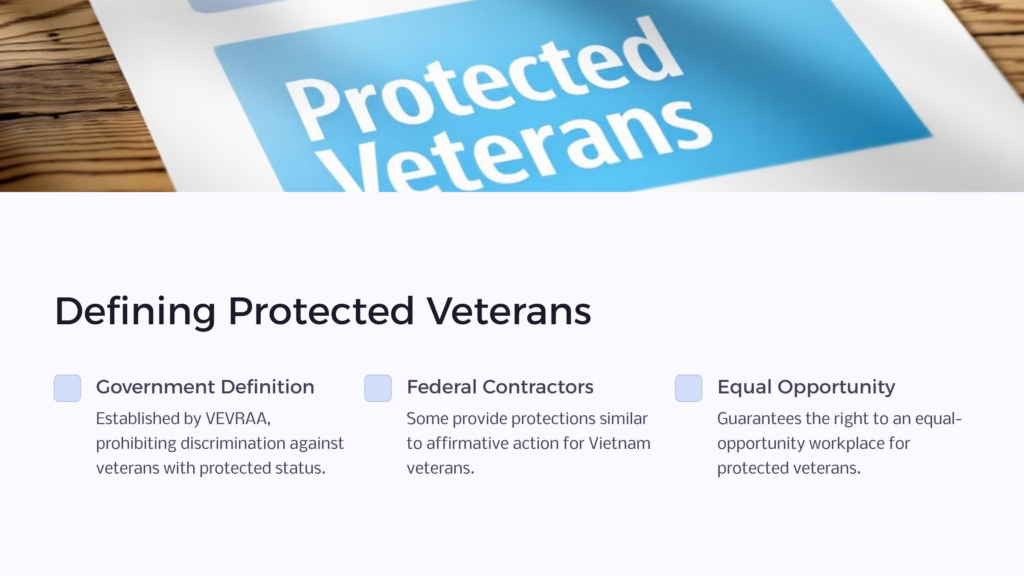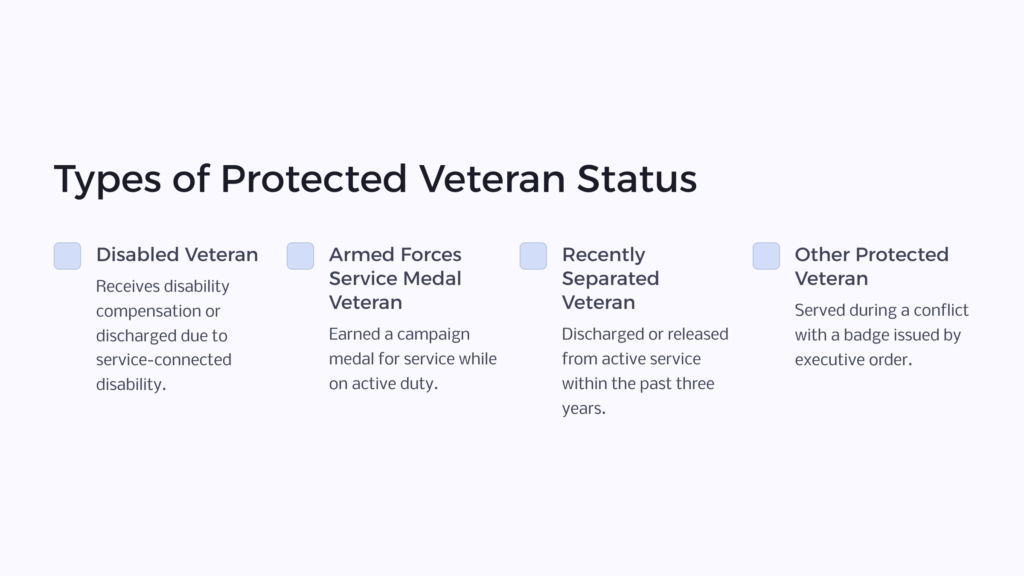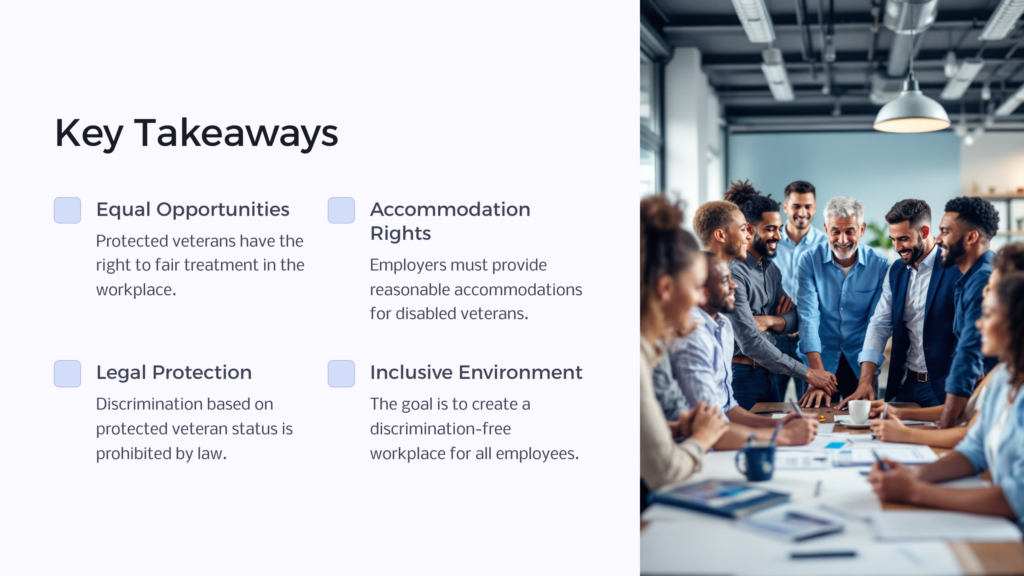A protected veteran is a former United States Armed Forces member who is currently shielded from discrimination based on their military service. Veterans with disabilities, those who have recently separated from the military, those who have earned an active duty wartime or campaign badge, and those with an Armed Forces service medal are all eligible for this status. This article will explore in depth what is a protected veteran.
How Does the Government Define a Protected Veteran?

The protected veteran status was established by an addition to the Vietnam Era Veterans’ Readjustment Assistance Act of 1974 (VEVRAA). According to the VEVRAA, a protected veteran may be considered a “disabled veteran,” “recently separated veteran,” “active duty wartime or campaign badge veteran,” or “Armed Forces service medal veteran.” Discrimination against any veteran with protected status is prohibited. Some federal contractors and human resource departments that hire Vietnam veterans provide these former military, naval, and air service members with protections similar to affirmative action.
What Types of Protected Veteran Statuses Are Recognized Under Federal Law?

If you fall into one of these groups of veterans, VEVRAA considers you to be a “protected veteran.”
- Disabled veteran: A person who served in the U.S. marine corps, navy, coast guard, or air force and is currently receiving (unless they have already collected their military retired pay) disability compensation under laws prescribed by the Secretary of Veterans Affairs or who was released or discharged from active duty due to a service-connected disability.
- Other protected veteran: Someone who was a member of the United States Armed Forces during a conflict or in an expedition or campaign for which a badge was issued by an executive order governed by the Department of Defense.
- Recently separated veteran: An individual who served in the United States armed forces and was discharged or released from active service within the past three years.
- Armed Forces Service Medal Veteran: A former United States Armed Forces member who earned a campaign medal for service while on active duty.
What Benefits Do Protected Veterans Have Access To?
The Vietnam Era Veterans’ Readjustment Assistance Act guarantees protected veterans the right to an equal-opportunity workplace. It is illegal to discriminate against a protected veteran in any way related to their military service, including by denying them a job, demoting them, firing them, or paying them less.
Any military veteran with a service-connected disability can benefit from “reasonable accommodation” in a workplace managed by a federal contractor. Employers are required to provide disabled workers with reasonable accommodations that enable them to perform their jobs unless doing so would impose an unreasonable burden or expense on the business. Similarly, if an applicant is a disabled veteran, the employer will make reasonable accommodations so that they may complete the application process and be evaluated for the position.
How Does Being a Protected Veteran Affect Job Opportunities?
Many protected veterans who are eligible for protection against employment discrimination due to their military status can also enjoy additional 100 disabled veterans benefits, such as employment preference, support programs, transitional services, and more.
Several obstacles make it difficult for veterans to enter and advance in the workforce after participating in United States military operations. Among them is the fact that the workplace is evolving faster while its infrastructure is lagging. The best jobs for veterans are hampered by prejudice, unequal access to resources, employers’ failure to appreciate veterans’ unique skillsets acquired during military service, and bureaucratic roadblocks. This is why protected veteran rights are crucial.
The Uniformed Services Employment and Reemployment Rights Act (USERRA) provides additional benefits to protected veterans. If a protected veteran had to take time away from work to serve in the armed forces, that person may have a right to be rehired by their previous employer at the same job they would have had if they hadn’t been called to active duty.
What Are the Responsibilities of Employers Towards Protected Veterans?
Protected veterans have a legal right to reasonable accommodation from their employers. Workplaces are required to provide disabled veterans with reasonable accommodations, such as:
- Making written materials available in alternative formats (including audiotape, large print, or Braille).
- Scheduling shifts differently or changing work hours.
- Having all stages of the hiring process (including advertising, interviews, and exams) in accessible locations.
- Facilitating employee meetings in easily accessible areas.
- Providing adaptive equipment or services.
What Is the Difference Between a Protected Veteran and a Non-Protected Veteran?
First, what is a veteran? A veteran is a person who has served in the armed forces, such as the navy national guard, marine corps, coast guard, or air force. If a service member receives a discharge other than a dishonorable one, they are considered a military veteran.
On the other hand, what is a protected veteran? These individuals fall into one of the four categories we mentioned earlier. All employees covered by these laws are veterans, although not all veterans meet the criteria for protection.
How Do I Know If I Am a Protected Veteran?
You must meet one of the following conditions to be considered a protected veteran under VEVRAA: you must be a disabled veteran, a recently separated veteran, a veteran with an Armed Forces service medal, or an active duty wartime or campaign badge veteran.
Identifying an eligible opportunity to serve is all that’s required to gain protected veteran status, and in past years, vets of the Global War on Terror and those serving in Operation Inherent Resolve, as well as COVID-19 response, have all qualified.
How Does the Veterans Affairs Office Verify Protected Veteran Status?

The VA Center for Verification and Evaluation (CVE) typically asks for personal information such as a DD-214 or other formal military documentation to verify veteran status.
As mentioned earlier, protected veteran status is governed by VEVRAA. To ensure adherence to the Vietnam Era Veterans’ Readjustment Assistance Act of 1974, federal contractors and human resource departments must provide Department of Labor inspectors access to their premises. Vietnam veterans who believe they have been treated unfairly under VEVRAA protections can report the issue to the Federal Contract Compliance Programs Office (OFCCP).
Wrapping Up

Protected veteran employees have the right to equal opportunities in the workplace and to request accommodations that will allow them to perform their jobs. Employment discrimination based on this status is prohibited.
Workers employed by a federal contractor and other companies that have business with the United States federal government are expressly protected by this status. An organization can be excluded from future federal contracts and may have ongoing contracts terminated if they’re proven to have discriminated against a protected veteran. Finally, the ultimate goal of protected veteran status is to create an environment free from discrimination for all employees.
Learn more about the benefits that veterans can enjoy and discover the advice we offer for free by visiting our website at Benefits.com.
 Benefits.com Advisors
Benefits.com Advisors
With expertise spanning local, state, and federal benefit programs, our team is dedicated to guiding individuals towards the perfect program tailored to their unique circumstances.
Rise to the top with Peak Benefits!
Join our Peak Benefits Newsletter for the latest news, resources, and offers on all things government benefits.





















